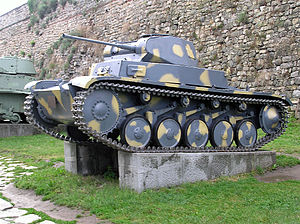Panzer II
| Panzerkampfwagen II | |
|---|---|

Panzer II at the Belgrade Military Museum
|
|
| Type | Light tank |
| Place of origin | Nazi Germany |
| Service history | |
| In service | 1936–1945 |
| Wars | World War II |
| Production history | |
| Designed | 1934 |
| Produced | 1935–1943 |
| No. built | 1,856 (excluding conversions) |
| Specifications (Ausf. A-C) | |
| Weight | 8.9 t (8.8 long tons) |
| Length | 4.81 m (15 ft 9 in) |
| Width | 2.22 m (7 ft 3 in) |
| Height | 1.99 m (6 ft 6 in) |
| Crew | 3 (commander/gunner, driver, loader) |
|
|
|
| Armor | 5–14.5 mm (0.20–0.57 in) |
|
Main
armament |
1 × 2 cm KwK 30 Ausf. a–F 1 × 2 cm KwK 38 Ausf. J–L |
|
Secondary
armament |
1 × 7.92 mm Maschinengewehr 34 |
| Engine |
Maybach HL 62TRM 6-cylinder petrol 140 PS (138 hp, 103 kW) |
| Power/weight | 15.7 PS (11.6 kW) / tonne |
| Suspension | Leaf spring |
|
Operational
range |
200 km (120 mi) |
| Speed | 40 km/h (25 mph) |
The Panzer II is the common name used for a family of German tanks used in World War II. The official German designation was Panzerkampfwagen II (abbreviated PzKpfw II).
Although the vehicle had originally been designed as a stopgap while larger, more advanced tanks were developed, it nonetheless went on to play an important role in the early years of World War II, during the Polish and French campaigns. The Panzer II was the most numerous tank in the German Panzer divisions beginning with the invasion of France. It was used in both North Africa against the Western Allies and on the Eastern Front against the Soviet Union.
The Panzer II was supplanted by the Panzer III and IV by 1940/1941. By the end of 1942, it had been largely removed from front line service and it was used for training and on secondary fronts. The turrets of the then-obsolete PzKpfw Is and PzKpfw IIs were reused as gun turrets on specially built defensive bunkers, particularly on the Atlantic Wall. Production of the tank itself ceased by 1943, but its chassis remained in use as the basis of several other armored vehicles, chiefly self-propelled artillery and tank destroyers such as the Wespe and Marder II.
In 1934, delays in the design and production of the Panzer III and Panzer IV medium tanks were becoming apparent. Designs for a stopgap tank were solicited from Krupp, MAN, Henschel, and Daimler-Benz. The final design was based on the Panzer I, but larger, and with a turret mounting a 20 mm anti-tank gun. Production began in 1935, but it took another eighteen months for the first combat-ready tank to be delivered.
...
Wikipedia
